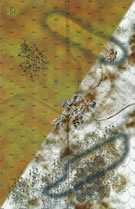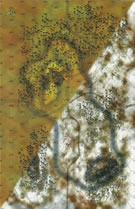|
Fly By Night Maple Leaf Brigade #3 |
||
|---|---|---|
| (Defender) Canada | vs | Soviet Union (Attacker) |
| Formations Involved | ||
|---|---|---|
| Canada |  |
27th Brigade Group |
| Soviet Union |  |
207th "Berlinskaya" Rifle Division |

|
| Overall Rating, 2 votes |
|---|
|
4
|
| Scenario Rank: --- of 964 |
| Parent Game | Maple Leaf Brigade |
|---|---|
| Historicity | Alt-History |
| Date | 1951-10-03 |
| Start Time | 21:00 |
| Turn Count | 40 |
| Visibility | Night |
| Counters | 193 |
| Net Morale | 1 |
| Net Initiative | 1 |
| Maps | 2: 24, 25 |
| Layout Dimensions | 56 x 43 cm 22 x 17 in |
| Play Bounty | 203 |
| AAR Bounty | 161 |
| Total Plays | 2 |
| Total AARs | 2 |
| Battle Types |
|---|
| Hill Control |
| Inflict Enemy Casualties |
| Road Control |
| Urban Assault |
| Conditions |
|---|
| Off-board Artillery |
| Reinforcements |
| Scenario Requirements & Playability | |
|---|---|
| Elsenborn Ridge | Maps |
| Maple Leaf Brigade | Base Game |
| Road to Berlin | Counters |
| Introduction |
|---|
|
The Red Army crushed the fascists in the Great Patriotic War thanks to the mobility of their mechanized formations and the soundness of their deep battle operational doctrine. For the next war, the newly-renamed Soviet Army planned to execute the same doctrine, but now all of its formations would be mobile. They would still have to dismount and deal with organized resistance, however. Of course, the mobility of the Soviet forces worked best against the horse drawn transport of the non-mechanized forces of the Nazi empire and its allies. How it would work against an opposing highly mobile defense, especially at night was an open question. |
| Conclusion |
|---|
|
Fighting in positional defense took away the Canadians’ advantage of mobility, but did allow them to channel the Soviet advance toward their deadly anti-tank guns. But the Canadians would need armor of their own to deal with the big Soviet tanks; as had been proven in Korea, the spring-loaded PIAT anti-tank weapon might as well have been the child’s toy it resembled when faced with the T34/85 or T44. The Soviets typically disdained lessons from other armies as being less applicable to their doctrine and force structure. They did, however, notice the impact of the deep penetrations and the road interdiction pursued by the North Koreans and intended to use that approach against the western European armies which depended heavily on secure movement avenues behind their front. |
| AFV Rules Pertaining to this Scenario's Order of Battle |
|---|
|
| 2 Errata Items | |
|---|---|

|
The reduced direct fire value in Kursk: Burning Tigers is 4-4. (plloyd1010
on 2015 Jul 31)
|

|
Kommissars never get morale or combat modifiers. Ignore misprints. (Shad
on 2010 Dec 15)
|
| What a Rush |
|---|
|
This big battle used most of the Canadian toys in this set. Two Canadian battalions supported by some armored cars, AT guns, and a reinforcing company of Centurions had to stop a reinforced Soviet motor rifle regiment of three battalions of infantry, one of SMGs, a bunch of MGs, some AT guns, and a battalion of tanks consisting of 4 platoons of T34s and 5 of T44s. It was a big battle packed into two maps. The night attack by the Soviets was to secure town hexes and high hill hexes, and inflict Canadian losses. The Canadians chose to place their Kangaroo mounted battalion forward, spread across the line in company strength positions. The foot battalion was dug in along the line of hills in the rear. The Soviets sent two battalions and a provisional battalion of MGs to attack in parallel, pinning the Canadian front and opening their right flank for exploitation by tank and truck-mounted follow on battalions. Soviet plans rarely survive contact with Canadian infantry. In this case the Soviet MG battalion swept the northernmost town of Canadian defenders, who chose to fall back instead of face the withering Soviet fire. In the center, the Soviet attack on the main town was stymied by stout Canadian defense, as in the south, where two dug in platoons held up a battalion long enough for reinforcing infantry and MG platoons arrived to help them pulverize the Soviet force. But an opening was found in the thin Canadian line, and Soviet hordes poured through, smashing into the southernmost second line hill defenders. This is where the Soviet attack ground to a halt. Mobile Canadian platoons carried out multiple local counterattacks along the Soviet flank and rear. Losses mounted rapidly. After about 4 hours of battle the Soviets had enough. They lost more than 2 battalions of infantry, almost the entire battalion of tanks. The Canadians lost a few platoons. Major Canadian victory. |
| 0 Comments |
| Maple Leaf Brigade #3 - Fly By Night |
|---|
|
The Soviets have three objectives in this scenario, control of town hexes, control the 40m hill hexes on map 25, and have an equal or higher initiative at the end of play. The main Soviet force attacked the large town on map 24 while two smaller forces drove for the 40m hill hexes. The town was a tougher nut to crack as the Canucks repulsed the Soviet attacks only giving up 3 town hexes by the EOG. Night scenario, visibility was 2 hexes, which added the Canucks. Played using optional rules 15 & 16, illumination and house rule on efficient ATGs if they had a moral of 8 or higher. |
| 0 Comments |

 MaLB002
MaLB002 
































